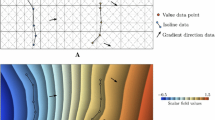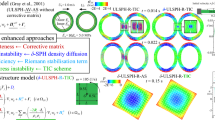Abstract
We introduce a new method for implicit structural modeling. The main developments in this paper are the new regularization operators we propose by extending inherent properties of the classic one-dimensional discrete second derivative operator to higher dimensions. The proposed regularization operators discretize naturally on the Cartesian grid using finite differences, owing to the highly symmetric nature of the Cartesian grid. Furthermore, the proposed regularization operators do not require any special treatment on boundary nodes, and their generalization to higher dimensions is straightforward. As a result, the proposed method has the advantage of being simple to implement. Numerical examples show that the proposed method is robust and numerically efficient.












Similar content being viewed by others
References
Briggs I (1974) Machine countouring using minimum curvature. Geophysics 39(1):39–48
Calcagno P, Chilès JP, Courrioux G, Guillen A (2008) Geological modelling from the field data and geological knowledge Part I. Modeling method coupling 3D potential-field interpolation and geological rules. Phys Earth Planet Inter 17:147–157
Caumon G, Collon P, Le Carlier de Veslud C, Viseur S, Sausse J (2009) Surface-based 3D modeling of geological structures. Math Geosci 41:927–945
Caumon G (2010) Towards stochastic time-varying geological modeling. Math Geosci 42:555–569
Caumon G, Gray G, Antoine C, Titeux M-O (2013) Three-dimensional implicit stratigraphic model building from remote sensing data on tetrahedral meshes: theory and application to regional model of La Popa Basin, NE Mexico. IEEE Trans Geosci Remote Sens 51(3):1613–1621
Chauris H, Noble M, Lambaré G, Podvin P (2002) Migration velocity analysis from locally coherent events in 2-D laterally heterogeneous media, Part I: theoretical aspects. Geophysics 67(4):1202–1212
Chauvin B, Lovely P, Stockmeyer J, Plesch A, Caumon G, Shaw J (2018) Validating novel boundary conditions for three-dimensional mechanics-based restoration: an extensional sandbox model example. AAPG Bull 102:245–266
Cherpeau N, Caumon G (2015) Stochastic structural modelling in sparse data situations. Petrol Geosci 21:233–247
Chilès J-P, Aug C, Guillen A, Less T (2005) Modeling the geometry of geological units and its uncertainty in 3D form structural data: the potential-field method. In: Orebody modeling and strategic mine planning, Spectrum Series Volume 14 355–362
Cowan EJ, Beatson RK, Fright WR, McLennan TJ, Mitchell TJ (2002) Rapid geological modeling. In: Applied structural geology for mineral exploration and mining, Kalgoorlie, Australia
Enriquez J, Thomann J, Goupillot M (1983) Applications of bidimensional spline functions to geophysics. Geophysics 48(9):1268–1273
Fehmers G, Höcker C (2003) Fast structural intepretation with structure-oriented filtering. Geophysics 68(4):1286–1293
Frank T (2007) 3D reconstruction of complex geological interfaces from irregularly distributed and noisy point data. Comput Geosci 33:932–943
Godefroy G, Bonneau F, Caumon G, Laurent G (2017) Stochastic association of fault evidences using graph theory and geological rules. In: 2017 RING meeting, Université de Lorraine-ENSG, Nancy
Gonçalves IG, Kumaira S, Guadagnin F (2017) A machine learning approach to the potential-field method for implicit modeling of geological structures. Comput Geosci 103:173–182
Grose L, Laurent G, Ailleres L, Armit R, Jessell M, Caumon G (2017) Structural data constraints for implicit modeling of folds. J Struct Geol 104:80–92
Hillier M, Schetselaar E, Kemp E, Perron G (2014) Three-dimensional modeling of geological surfaces using generelized interpolation with radial basis functions. Math Geosci 46:931–953
Jessell M, Ailleres L, de Kemp E, Lindsay M, Wellmann F, Hillier M, Laurent G, Carmichael T, Martin R (2014) Next generation three-dimensional geologic modeling and inversion. Soc Econ Geol Spec Publ 18:261–272
Lajaunie C, Courrioux G, Manuel L (1997) Foliation fields and 3D cartography in geology: Principles of a method based on potential interpolation. Math Geol 29(4):571–584
Laurent G (2016) Iterative thickness regularization of stratigraphic layers in discrete implicit modeling. Math Geosci 48:811–833
Laurent G, Ailleres L, Grose L, Caumon G, Jessell M, Armit R (2016) Implicit modeling of folds and overprinting deformation. Earth Planet Sci Lett 456:26–38
Ledez D (2003) Modélisation d’objets naturels par formulation implicite. Ph.D. Thesis, Université de Lorraine-ENSG, Nancy
Levy B (1999) Topologie Algorithmique, Combinatoire et Plongement. Ph.D. Thesis, Université de Lorraine-ENSG, Nancy
Mallet J-L (1989) Discrete smooth interpolation. ACM Trans Graph 8:121–144
Mallet J-L (1992) Discrete smooth interpolation in geometric modeling. Comput Aided Des 24:178–191
Mallet J-L (1997) Discrete modeling for natural objects. Math Geol 29(1):199–219
Mallet J-L (2004) Space-time mathematical framework for sedimentary geology. Math Geol 36(1):1–32
Mallet J-L (2014) Elements of mathematical sedimentary geology: the GeoChron model. EAGE
Mallet JL (1984) Automatic contouring in presence of discontinuities. In: Verly G, David M, Journel AG, Marechal M (eds) Geostatistics for natural resources characterization, Part 2. D. Reidel Publishing Company, Dordrecht, pp 669–677
Martin R, Boisvert J (2017) Iterative refinement of implicit boundary models for improved geological feature reproduction. Comput Geosci 109:1–15
Moes N, Belytscheko T (2002) Extended finite element for cohesive crack growth. Eng Fract Mech 69:813–833
Moyen R (2005) Paramétrisation 3D de l’espace en géologie sédimentaire: le modèle GeoChron. Ph.D. Thesis, Université de Lorraine-ENSG, Nancy
Newman T, Yi H (2006) A survey of the marching cubes algorithm. Comput Graph 30:854–879
Ramón MJ, Pueyo EL, Caumon G, Briz JL (2015) Parametric unfolding of flexural folds using palaeomagnetic vectors. Geol Soc Lond 425:247–258
Renaudeau J, Irakarama M, Laurent G, Maerten F, Caumon G (2018) Implicit modeling of geological structures: a Cartesian grid method handling discontinuities with ghost points. In: 41st international conference on boundary elements and other mesh reduction methods, New Forest
Renaudeau J, Malvesin E, Maerten F, Caumon G (2017a) Towards continuous equations behind implicit stratigraphic modeling. In: 2017 RING meeting, Université de Lorraine-ENSG, Nancy
Renaudeau J, Malvesin E, Maerten F, Caumon G (2017b) The weighted minimization criterion as a physical way to handle thickness variation in implicit structural modeling. In: 2017 RING meeting, Université de Lorraine-ENSG, Nancy
Renaudeau J, Malvesin E, Maerten F, Caumon G (2019) Implicit structural modeling by minimization of the bending energy with moving least squares functions. Math Geosci 51:693–724
Smith W, Wessel P (1990) Gridding with continous curvature splines in tension. Geophysics 55(3):293–305
Souche L, Lepage F, Iskenova G (2013) Volume based modeling—automated construction of complex structural models. In: 75th EAGE conference and exhibition
Tertois A-L (2007) Création et modification de modèles géologiques par champs de potentiel. Application au modèle GeoChron. Ph.D. Thesis, Université de Lorraine-ENSG, Nancy
Turk G, O’Brien J (2002) Modelling with implicit surfaces that interpolate. ACM Trans Graph 21:855–873
Wessel P, Bercovici D (1998) Interpolation with splines in tension: a Green’s function approach. Math Geol 30(1):77–93
Wu X (2017) Building 3D subsurface models conforming to seismic structural and stratigraphic features. Geophysics 82:IM21–IM30
Wu X, Hale D (2015) Horizon volumes with interpreted constraints. Geophysics 80:IM21–IM33
Acknowledgements
The authors would like to thank Total for the data used in Fig. 1, Hao Huang (ExxonMobil) for the data used in Fig. 9, and Benjamin Chauvin (previously RING, currently Harvard), IFPEN, C&C Reservoirs for the data used in Fig. 10. Modeste Irakarama would also like to thank Paul Cupillard (RING) and Pierre Thore (Total) for their encouragement to publish this work. We are very thankful to three anonymous reviewers for the time they dedicated to review this paper. This work was done in the frame of the RING project at Université de Lorraine. We would therefore like to thank the sponsors of the RING-GOCAD Consortium managed by ASGA for their support. Software corresponding to this paper is available to consortium members in the SIGMA package.
Author information
Authors and Affiliations
Corresponding author
Ethics declarations
Conflict of interest
The authors declare that they have no conflict of interest.
Appendix
Appendix
The analytic expressions of terms appearing in the formulas for \({\mathcal {R}}(\phi )\), as proposed in Sect. 5, are given below
Rights and permissions
About this article
Cite this article
Irakarama, M., Laurent, G., Renaudeau, J. et al. Finite Difference Implicit Structural Modeling of Geological Structures. Math Geosci 53, 785–808 (2021). https://doi.org/10.1007/s11004-020-09887-w
Received:
Accepted:
Published:
Issue Date:
DOI: https://doi.org/10.1007/s11004-020-09887-w




